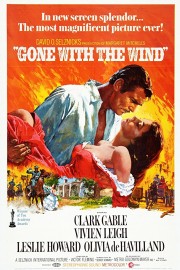Gone With the Wind
David O. Selznick’s “Gone With the Wind” is one of the towering, epic achievements in American cinema. The history it presents is dubious, at best, but it’s a marvelous piece of storytelling and film production. If you think about the buzz, and near-universal acclaim, met with Peter Jackson’s “Lord of the Rings” trilogy, that is what “Gone With the Wind” was to audiences in 1939. Margaret Mitchell’s novel was the toast of the modern era, and making it into a movie was a genuine event. Over 75 years later, it remains a great film, even if it’s hard to look at it’s idealized view of the South with anything but a sigh.
You’ll notice that I called this “David O. Selznick’s ‘Gone With the Wind'” rather than “Victor Fleming’s ‘Gone With the Wind.'” Victor Fleming is the credited director, and the won who took home the directing Oscar for the film, but as talented as he was (he also had “The Wizard of Oz” in the same year), the vision behind the film was that of producer Selznick, who wound up chasing this film’s success for the rest of his career (although he won another Best Picture Oscar the next year for Alfred Hitchcock’s “Rebecca”). Other directors who worked on the film included George Cukor and Sam Wood, but neither lasted long– only Fleming survived the process, although Selznick was the real driving force of the film. This is a producer’s movie through and through, all spectacle and sweeping emotions. Elegant storytelling this is not, but an elegant production? In every way, shape and form, and that comes from Selznick.
Before we continue, let’s discuss the matter of slavery, and how it’s presented in the film. From the opening title cards, it’s plain that this is a very biased story towards the “Old South,” discussing it in sentimental, romantic terms like some discuss Camelot, so needless to say, the North is viewed at unfavorably. For the main characters (well, the main white characters), slavery is a part of a grand tradition that is about to be lost to the ravages of war. Although Mammy (Hattie McDaniel, who deservedly won an Oscar for her performance) and Prissy (Butterfly McQueen) are given some humanity and nuance, they still have some truly hamfisted dialogue and moments that feel right at home with the minstrel shows of the era and gross characterizations of the more-repellant “Birth of a Nation.” That the film avoids being as blatantly offensive as D.W. Griffith’s landmark is a shrewd piece of craft by Selznick and screenwriter Sidney Howard (a scene with the KKK was removed because it might bring undue scrutiny to politicians who were members), but this film wasn’t just about the Civil War, and the ways it changed life in the South. This film is about a woman whose life is turned upside down, and whose love life is the beating, complicated heart of the story. The Civil War is just the setting for this story, not the subject.
That brings us to Scarlett O’Hara, the protagonist of “Gone With the Wind,” played by Vivien Leigh in one of the great performances in all the movies. Scarlett is a modern woman, independent and feisty and driven by her lust. She wants marriage, but on her terms, which is part of why, when she marries Charles Hamilton (Rand Brooks) before he goes off to war, it’s not for love, but for the love of the status being married gives her. When Charles dies, she does her duty and mourns, but the life of a widow is not for her. She marries a second time after the war, but it’s not for love this time, either: her “husband” is going to pay the taxes necessary for her to keep Tara, her beloved family plantation. She then begins a lumber business, with the help of money her husband is owed, and becomes a smart businesswoman, all the while keeping her “true love,” Ashley Wilkes (Leslie Howard), nearby, even though he’s married to her friend, Melanie (Olivia de Havilland). After her second marriage ends comes her inevitable coupling with Rhett Butler (Clark Gable), a vulgar opportunist who is the only man who sees Scarlett clearly. He looks like a gentleman, but the way he speaks to Scarlett is anything but gentleman-like. They’ve crossed paths many times over the course of the film before they get married, so we know that in a way, they belong together. But Scarlett is a woman no man can truly tame, even someone as rough and tumble as Rhett. By the end, even he’s worn out with her, leading to his famous words, “Frankly my dear, I don’t give a damn.” The dance between these two is a delight to watch, and helps keep the movie moving at a brisk pace, which is of great importance for a nearly four-hour film. As Scarlett and Rhett, Gable and Leigh are a scintillating pair, fueling one of the great love stories in movie history. “Titanic” has nothing on this film.
That goes for the film as a whole, as well. It’s obvious to anyone who’s seen both that “Titanic” was very much modeled after “Gone With the Wind”; unfortunately, James Cameron’s screenplay lacks the lingual poetry of Mitchell’s story by way of Howard’s script. That is a big part of what elevates Selznick’s production to the level of art. The film is a stunning, beautiful epic, with gorgeous art direction and costumes, great Technicolor cinematography, and an unforgettable score by Max Steiner. The story, however, is what makes it a film for the ages, with so many memorable moments and entertaining sequences that it’s almost criminal. Selznick made a masterpiece. He may not have been the person in the director’s chair, but he was the one responsible for making the film that has charmed audiences for 75 years, and will continue to do so for 75 more, and beyond.










